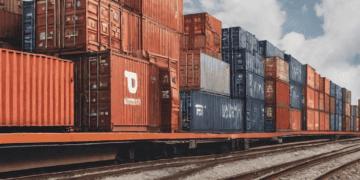In recent years, the landscape of intermodal transportation has seen a significant shift propelled by a confluence of factors, including infrastructure enhancements, evolving consumer behaviors, and unprecedented global challenges. This transformation has not only impacted the traditional flow of goods but has also accentuated the pivotal role played by intermodal networks in the supply chain.
Joni Casey, President and CEO of the Intermodal Association of North America (IANA), remarks on the seismic impact of the pandemic and the subsequent surge in consumer goods purchasing. The ebb and flow of intermodal volumes, disrupted by the pandemic’s onset, saw a distinct shift, as international and domestic loads experienced uncharacteristic fluctuations.
IANA’s report highlights a 3.6% surge in total North American intermodal volume for 2021, effectively reversing the declines observed in preceding years. However, this surge was not without its challenges. Terminal congestion, weather disruptions, and shortages in labor and equipment contributed to a fluctuating pattern, rising significantly in the first half before tapering off in the latter part of the year.
Intermodal transportation, involving the movement of containerized products through multiple transport modes, has seen a perceptible evolution in its perception. David Fisher from the University of Denver’s Transportation & Supply Chain Institute emphasizes the reliability, cost stability, and capacity advantages that major shippers have long appreciated.
While acknowledging potential perceptions of complexity, experts like Fisher and Sean Maharaj from consulting firm AArete underline the evolving simplicity of intermodal transport. Maharaj accentuates the cost efficiency and security of intermodal shipments, citing infrequent damage or theft due to the frequent checkpoints that enable robust tracking data.
The challenges faced by intermodal transportation in recent times have not gone unnoticed. Lawrence Gross from Gross Transportation Consulting underscores the capacity constraints and the subsequent strain on the system. The persistent congestion, a result of sustained high demand, has challenged the operational fluidity of intermodal networks.
However, amidst these challenges, the industry continues to evolve and adapt. Casey emphasizes the importance of various factors like terminal capacity, equipment dwell times, and container return in the functioning of the intermodal “pipeline.” Shippers are advised to consider distance, load type, and efficient alignment with rail schedules to optimize intermodal services.
Raul Alfonso, Executive VP and CCO at Port Tampa Bay, exemplifies how strategic planning and infrastructural investments have positioned the port to capitalize on Florida’s burgeoning growth. The port’s diversified cargo handling, expansive distribution center network, and strategic connectivity are pivotal in optimizing supply chain efficiency.
Meanwhile, at the Port Authority of New York and New Jersey, Michael Bozza underscores the unparalleled access to major markets and extensive warehousing within proximity. The port’s comprehensive infrastructure, including the ExpressRail network, highlights its commitment to integrating intermodal solutions into its growth strategy.
Similarly, Maryland Port Administration’s initiatives, such as the Howard Street Tunnel Expansion, reflect a forward-looking approach to infrastructure enhancement. These developments aim to bolster the port’s historical prominence in sectors like automobile handling and forest products while integrating modern technology to streamline operations.
Looking ahead, intermodal transportation remains a linchpin in the global supply chain. As stakeholders adapt to evolving demands, leverage technology, and enhance collaboration, intermodal networks are poised to continue as a pivotal element in facilitating efficient and resilient trade flows worldwide.
The concerted efforts of industry players and the increased focus on data-driven solutions, underscored by initiatives like the Federal Maritime Commission’s (FMC) Maritime Data Infrastructure, are indicative of a broader commitment towards fortifying the intermodal landscape.
In conclusion, as global dynamics continue to evolve, intermodal transportation stands resilient, leveraging innovation and collaboration to navigate challenges and emerge as a cornerstone of efficient supply chain operations.
Stay current with supply chain report news at The Supply Chain Report. For international trade tools, see ADAMftd.com.
#IntermodalTransportation #SupplyChainInnovation #LogisticsEvolution #IANA #PortTampaBay #PortAuthorityNYNJ #MarylandPort #SupplyChainOptimization #InfrastructureDevelopment #GlobalTrade #FMC #TransportationEfficiency #CostEffectiveShipping #RailLogistics #ContainerShipping #IntermodalNetworks #SupplyChainResilience #GlobalSupplyChain

















